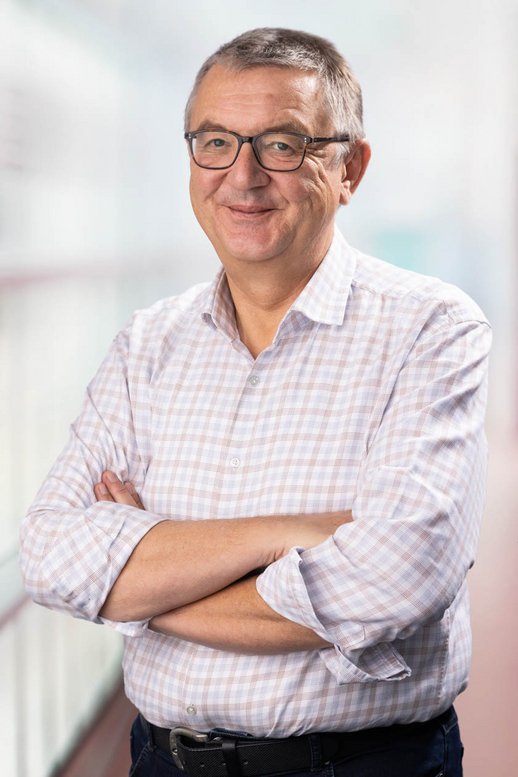Prof. Dr. Ralf Reski

Contact
University of Freiburg
T +49 761 203 6969
ralf.reski(at)biologie.uni-freiburg.de
Further Information
We have developed the moss Physcomitrella to a flagship model organism for basic biology and biotechnology. Precise genome engineering via homologous recombination, haploidy of the plant, highly controlled growth conditions, and a sequenced genome facilitate gene discovery and dissection of signalling pathways. Surprisingly, the moss genome comprises about 12,000 more protein-encoding genes than the human genome. We ask what their function is, how they evolved, and how they contributed to the conquest of land by plants some 500 million years ago. This event dramatically changed life on Earth and prepared the ground for the evolution of complex animals on land. Because most moss tissues are single cell layers, we can analyse signalling events across scales from sub-cellular levels to the whole plant. In these analyses, we pay special interest to the reprogramming of stem cells during development. In one of our applied fields, we develop biopharmaceuticals for the market. The first moss-made drug has successfully passed phase one clinical trials. Another candidate is human complement factor H, a central immune regulator. So far, only Physcomitrella is able to produce it recombinantly, and this protein may be helpful in a variety of human diseases, including kidney diseases, eye disease and COVID-19.
Mosses saw dinosaurs come and go and they saw us humans coming. If we are not careful they will see us go too.
10 selected publications
- Convergence of sphingolipid desaturation across over 500 million years of plant evolution.
Resemann HC, Herrfurth C, Feussner K, Hornung E, Ostendorf AK, Gömann J, Mittag J, van Gessel N, Vries J, Ludwig-Müller J, Markham J, Reski R*, Feussner I* (2021).
Nature Plants 7:219-232.
*corresponding - RecQ Helicases Function in Development, DNA Repair, and Gene Targeting in Physcomitrella patens.
Wiedemann G, van Gessel N, Köchl F, Hunn L, Schulze K, Maloukh L, Nogué F, Decker EL, Hartung F, Reski R (2018).
Plant Cell 30:717-736 - Enabling the water-to-land transition.
Reski R (2018).
Nature Plants 4:67-68. - A phenol-enriched cuticle is ancestral to lignin evolution in land plants.
Renault H, Alber A, Horst NA, Lopes AB, Fich EA, Kriegshauser L, Wiedemann G, Ullmann P, Herrgott L, Erhardt M, Pineau E, Ehlting J, Schmitt M, Rose JKC, Reski R*, Werck-Reichhart D* (2017).
Nature Communications 8:14713.
*corresponding - Origin and function of stomata in the moss Physcomitrella patens.
Chater CC, Caine RS, Tomek M, Wallace S, Kamisugi Y, Cuming AC, Lang D, MacAlister CA, Casson S, Bergmann DC, Decker EL, Frank W, Gray JE, Fleming A, Reski R*, Beerling DJ* (2016).
Nature Plants 2:16179.
*corresponding - Identification of targets and interaction partners of arginyl-tRNA protein transferase in the moss Physcomitrella patens.
Hoernstein SN, Mueller SJ, Fiedler K, Schuelke M, Vanselow JT, Schuessele C, Lang D, Nitschke R, Igloi GL, Schlosser A, Reski R (2016).
Molecular and Cellular Proteomics 15:1808-18022. - A single homeobox gene triggers phase transition, embryogenesis and asexual reproduction.
Horst NA, Katz A, Pereman I, Decker EL, Ohad N*, Reski R* (2016).
Nature Plants 2:15209.
*corresponding - Plasma membrane-targeted PIN proteins drive shoot development in a moss.
Bennett TA, Liu MM, Aoyama T, Bierfreund NM, Braun M, Coudert Y, Dennis RJ, O'Connor D, Wang XY, White CD, Decker EL, Reski R, Harrison CJ (2014).
Current Biology 24:2776-2785 - Quantitative analysis of the mitochondrial and plastid proteomes of the moss Physcomitrella patens reveals protein macrocompartmentation and microcompartmentation.
Mueller SJ, Lang D, Hoernstein SN, Lang EG, Schuessele C, Schmidt A, Fluck M, Leisibach D, Niegl C, Zimmer AD, Schlosser A, Reski R (2014).
Plant Physiology 164:2081-2095. - Transcriptional control of gene expression by microRNAs.
Khraiwesh B, Arif MA, Seumel GI, Ossowski S, Weigel D, Reski R*, Frank W* (2010).
Cell 140:111-122.
*corresponding



